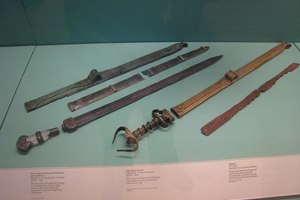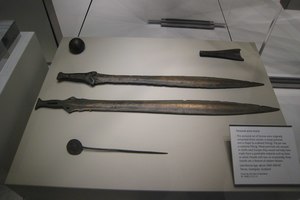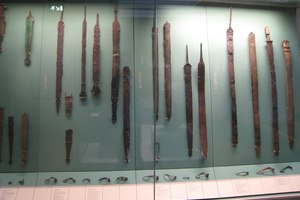Celtic swords
The Celts had advanced metallurgy, surpassing even the Romans of the same time period. They crafted high-quality long swords on a large scale. Numerous Celtic swords from different periods have been discovered, classified into several types according to the widely accepted system of the La Tène culture periodization:
- La Tène I swords (450-250 BCE). The blade length of these swords ranges from 55 to 65 cm, with one exception reaching 80 cm. All these swords are double-edged with a pointed tip and belong to the thrusting-slashing type. The distinctive feature of these early weapons is the unique shape of the pommel.
- La Tène II swords (250-120 BCE). The swords became primarily slashing weapons. The sword tip became rounded, and the blade length gradually increased, reaching 75-80 cm. The weight of such a sword, including the hilt, was approximately 1 kg. While the old form of the pommel continued to be used in the Balkans, in Western Europe, it began to follow the contour of the sword more closely. They were extracted by the hundreds from Lake Neuchâtel in Switzerland, and although regional variations can be observed, mainly in the shape of the pommels, the La Tène Type II swords adequately reflect the characteristic features of swords from that period. The scabbards (usually made of iron) consisted of two plates, with the front plate slightly wider than the back plate, curving around it at the edges. The scabbards were reinforced with a decorative overlay on top and a tip that strengthened the entire construction from below.
- La Tène III swords (120-50 BCE). The blade length continued to increase, with some examples reaching 90 cm. Although swords with a pointed tip still existed, the rounded type became predominant. Long scabbards depicted in this group were found in Britain. The shape of the scabbards clearly follows the La Tène culture, but their significant length, about 84 cm, suggests they belong to a later period.
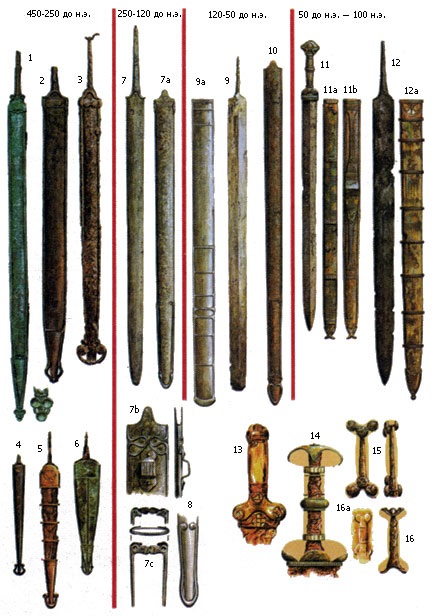 Sketches of Swords from Connolly's book. 1-12 depict the evolution of the Celtic sword. Scale 1:8. 1, 2, 3 - swords and scabbards from the Marne region in France. Museum of Saint-Germain. 4, 5, 6 - daggers and scabbards from the Marne region in France. Museum of Saint-Germain. 7 and 7a - sword and scabbard from La Tène. Basel Museum. Switzerland. 7b - reverse side of 7a, with a loop for suspension. 7c - scabbard tip of 7a. 8 - scabbard tip of a sword from France. Approx. 200 BCE. 9 and 9a - sword and scabbard from Port. 10 - scabbard found in the Thames near London. 11, 11a, and 11b - sword, as well as front and reverse sides of the scabbard from Embleton, Cumberland. 12, 12a - sword and scabbard from Yorkshire. 13-16 - sword hilts. 13 - from Thorp-Bradlington, Yorkshire. 14 - from Hod Hill, Dorset. 15 - from the Marne River Valley, France. 16 - from Hallstatt, Austria. 16a - depiction of a hilt from Pergamum, Turkey.
Sketches of Swords from Connolly's book. 1-12 depict the evolution of the Celtic sword. Scale 1:8. 1, 2, 3 - swords and scabbards from the Marne region in France. Museum of Saint-Germain. 4, 5, 6 - daggers and scabbards from the Marne region in France. Museum of Saint-Germain. 7 and 7a - sword and scabbard from La Tène. Basel Museum. Switzerland. 7b - reverse side of 7a, with a loop for suspension. 7c - scabbard tip of 7a. 8 - scabbard tip of a sword from France. Approx. 200 BCE. 9 and 9a - sword and scabbard from Port. 10 - scabbard found in the Thames near London. 11, 11a, and 11b - sword, as well as front and reverse sides of the scabbard from Embleton, Cumberland. 12, 12a - sword and scabbard from Yorkshire. 13-16 - sword hilts. 13 - from Thorp-Bradlington, Yorkshire. 14 - from Hod Hill, Dorset. 15 - from the Marne River Valley, France. 16 - from Hallstatt, Austria. 16a - depiction of a hilt from Pergamum, Turkey.
Ancient information about Celtic swords
There are also descriptions of Celtic swords by Roman authors that have been preserved. Dionysius describes how Celts would raise their swords above their heads, whirl them in the air, and then bring them down on their enemies as if chopping wood. It was this handling of the sword that instilled such terror in their opponents. However, Roman soldiers soon learned to deal with this.
Polybius reports that the Romans began to meet the first strike on the upper edge of their shields, reinforced with an iron covering. When struck against the iron edge, the Celtic sword would bend, and the Celtic warrior would be forced to straighten it with his foot, leaving him temporarily unarmed and vulnerable to attack by the legionary. Furthermore, the legionaries discovered that while the Celt was delivering a slashing strike with his sword, they could deflect it with their shield and strike at his abdomen from underneath the shield.
Polybius reports that the Romans began to take the first hit on the upper edge shield, reinforced with an iron pad. A blow on the iron edge bent the sword, and the Celtic warrior was forced to straighten it with his foot, which gave the legionary the opportunity to attack a temporarily unarmed opponent. In addition, the legionnaires found out that while the Celt is dealing a slashing blow with his sword, they can deflect it with a shield and hit it from under the shield in the stomach.
If we compare Celtic swords to Roman ones, they are most similar to spatha used by cavalry. In terms of their characteristics, Celtic swords are the opposite of the most famous Roman weapon, gladius, which was much shorter and designed exclusively for thrusting, not slashing blows.
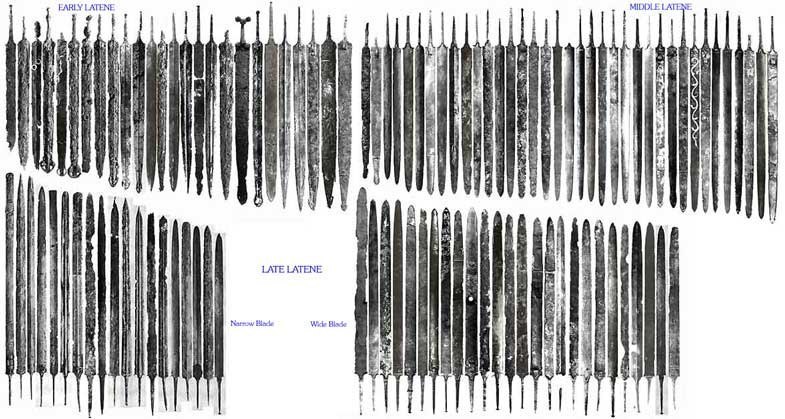 Celtic swords, arranged by period.
Celtic swords, arranged by period.
Related topics

 Gallery
Gallery






Literature
- Connolly P. Greece and Rome. Encyclopedia of Military History. Eksmo-Press. Moscow, 2000. Translated by S. Lopukhova and A. Khromova.
